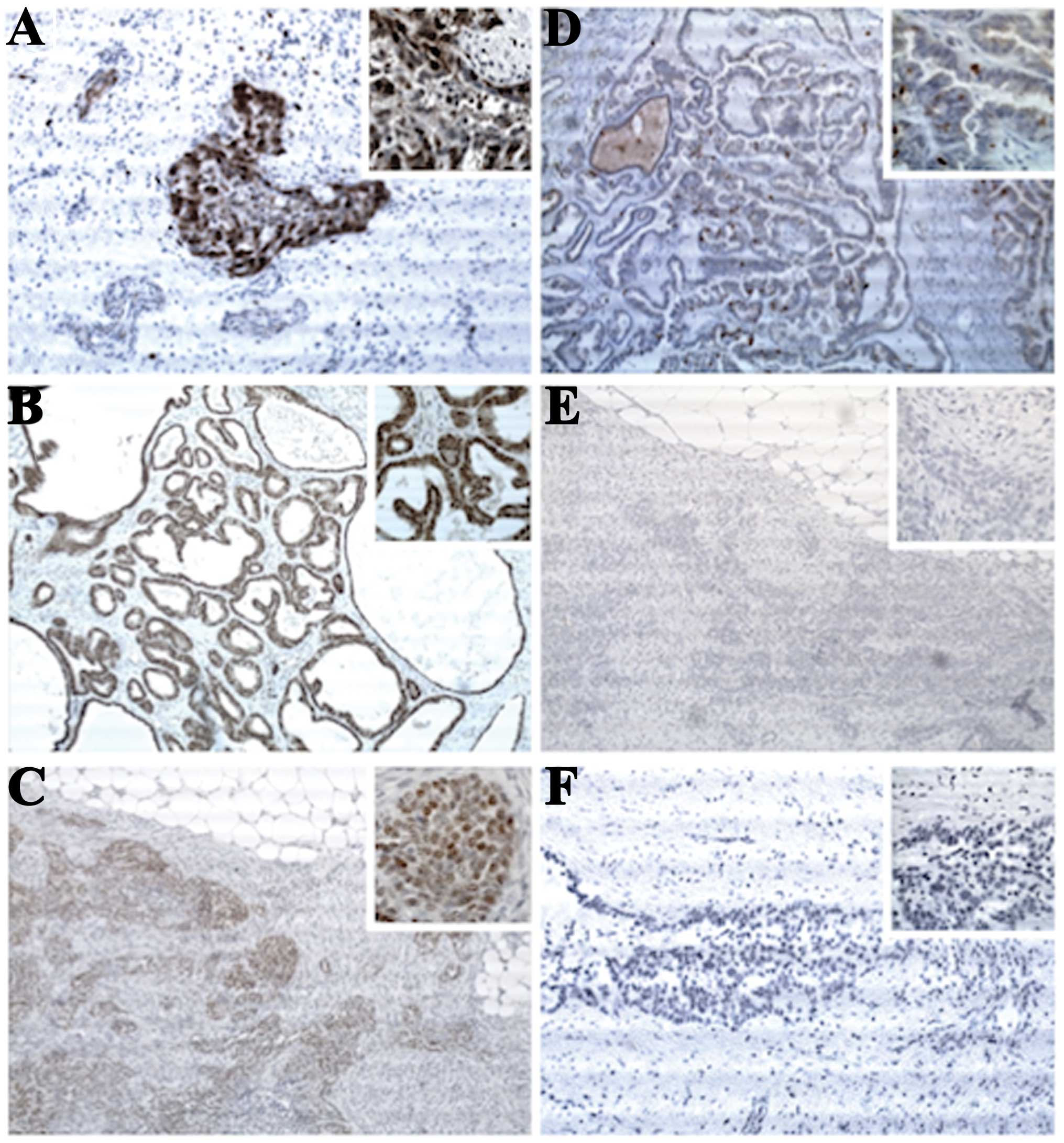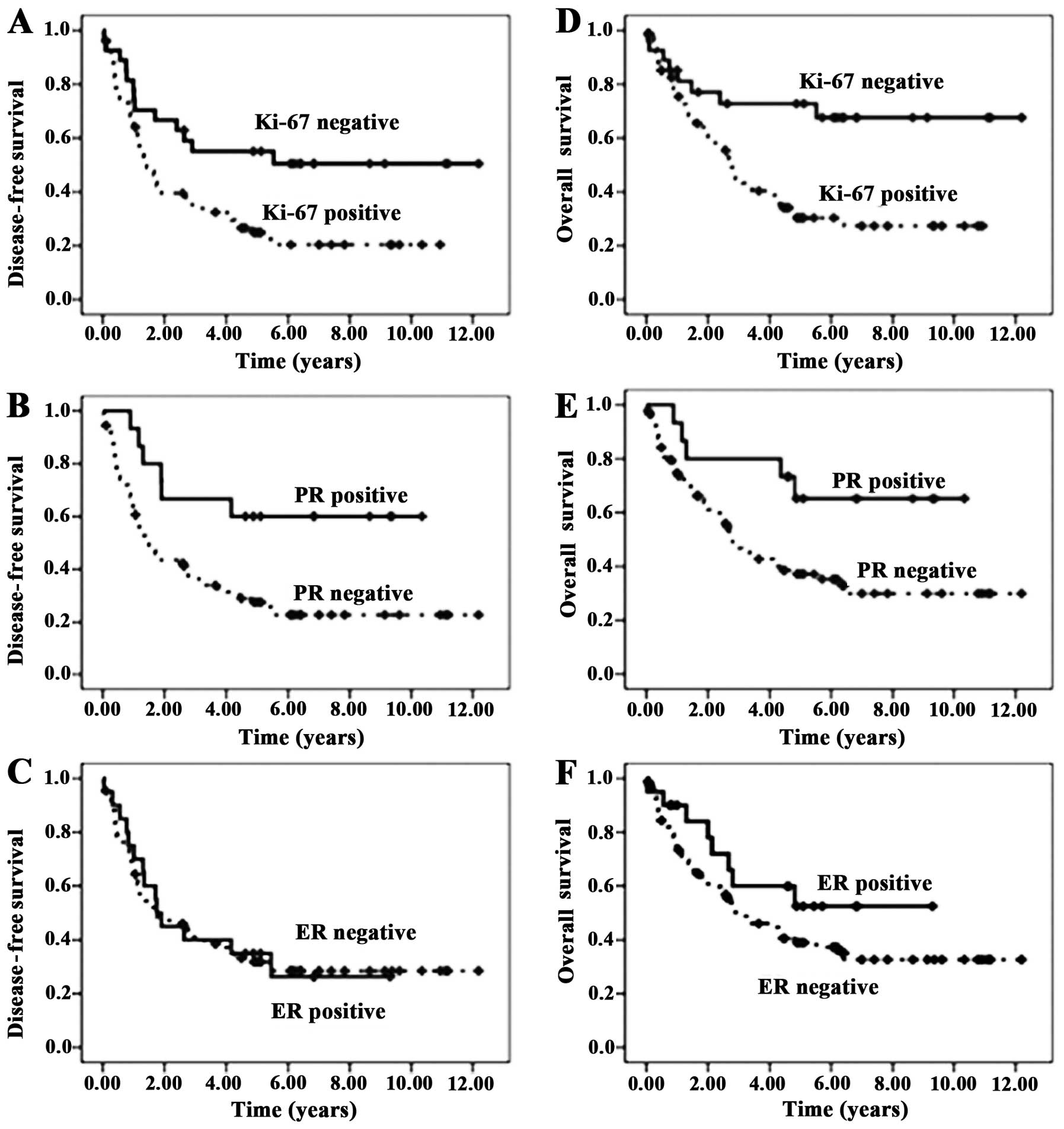|
1
|
Cannistra SA: Cancer of the ovary. N Engl
J Med. 351:2519–2529. 2004. View Article : Google Scholar : PubMed/NCBI
|
|
2
|
Gadducci A, Cosio S, Tana R and Genazzani
AR: Serum and tissue biomarkers as predictive and prognostic
variables in epithelial ovarian cancer. Crit Rev Oncol Hematol.
69:12–27. 2009. View Article : Google Scholar : PubMed/NCBI
|
|
3
|
Hanahan D and Weinberg RA: Hallmarks of
cancer: the next generation. Cell. 144:646–674. 2011. View Article : Google Scholar : PubMed/NCBI
|
|
4
|
Linden MD, Torres FX, Kubus J and Zarbo
RJ: Clinical application of morphologic and immunocytochemical
assessments of cell proliferation. Am J Clin Pathol. 97(Suppl 1):
S4–S13. 1992.PubMed/NCBI
|
|
5
|
Cattoretti G, Becker MH, Key G, et al:
Monoclonal antibodies against recombinant parts of the Ki-67
antigen (MIB 1 and MIB 3) detect proliferating cells in
microwave-processed formalin-fixed paraffin sections. J Pathol.
168:357–363. 1992. View Article : Google Scholar
|
|
6
|
Garzetti GG, Ciavattini A, Goteri G, et
al: Ki67 antigen immunostaining (MIB 1 monoclonal antibody) in
serous ovarian tumors: index of proliferative activity with
prognostic significance. Gynecol Oncol. 56:169–174. 1995.
View Article : Google Scholar : PubMed/NCBI
|
|
7
|
Viale G, Giobbie-Hurder A, Regan MM, et
al: Prognostic and predictive value of centrally reviewed Ki-67
labeling index in postmenopausal women with endocrine-responsive
breast cancer: results from Breast International Group Trial 1–98
comparing adjuvant tamoxifen with letrozole. J Clin Oncol.
26:5569–5575. 2008.PubMed/NCBI
|
|
8
|
Kritpracha K, Hanprasertpong J, Chandeying
V, Dechsukhum C and Geater A: Survival analysis in advanced
epithelial ovarian carcinoma in relation to proliferative index of
MIB-1 immunostaining. J Obstet Gynaecol Res. 31:268–276. 2005.
View Article : Google Scholar : PubMed/NCBI
|
|
9
|
Margulis V, Lotan Y, Karakiewicz PI, et
al: Multi-institutional validation of the predictive value of Ki-67
labeling index in patients with urinary bladder cancer. J Natl
Cancer Inst. 101:114–119. 2009. View Article : Google Scholar : PubMed/NCBI
|
|
10
|
Scambia G, Ferrandina G, Agostino GD, et
al: Oestrogen and progesterone receptors in ovarian carcinoma.
Endocr Relat Cancer. 3:293–301. 1998. View Article : Google Scholar
|
|
11
|
Zhao D, Zhang F, Zhang W, He J, Zhao Y and
Sun J: Prognostic role of hormone receptors in ovarian cancer: a
systematic review and meta-analysis. Int J Gynecol Cancer.
23:25–33. 2013. View Article : Google Scholar : PubMed/NCBI
|
|
12
|
Bizzi A, Codegoni AM, Landoni F, et al:
Steroid receptors in epithelial ovarian carcinoma: relation to
clinical parameters and survival. Cancer Res. 48:6222–6226.
1988.PubMed/NCBI
|
|
13
|
Geisler JP, Wiemann MC, Miller GA and
Geisler HE: Estrogen and progesterone receptor status as prognostic
indicators in patients with optimally cytoreduced stage IIIc serous
cystadenocarcinoma of the ovary. Gynecol Oncol. 60:424–427. 1996.
View Article : Google Scholar : PubMed/NCBI
|
|
14
|
Lee P, Rosen DG, Zhu C, Silva EG and Liu
J: Expression of progesterone receptor is a favorable prognostic
marker in ovarian cancer. Gynecol Oncol. 96:671–677. 2005.
View Article : Google Scholar : PubMed/NCBI
|
|
15
|
Sinn BV, Darb-Esfahani S, Wirtz RM, et al:
Evaluation of a hormone receptor-positive ovarian carcinoma subtype
with a favourable prognosis by determination of progesterone
receptor and oestrogen receptor 1 mRNA expression in formalin-fixed
paraffin-embedded tissue. Histopathology. 59:918–927. 2011.
View Article : Google Scholar
|
|
16
|
Andreasen PA, Kjøller L, Christensen L and
Duffy MJ: The urokinase-type plasminogen activator system in cancer
metastasis: a review. Int J Cancer. 72:1–22. 1997. View Article : Google Scholar : PubMed/NCBI
|
|
17
|
Nykjaer A, Conese M, Christensen EI, et
al: Recycling of the urokinase receptor upon internalization of the
uPA:serpin complexes. EMBO J. 16:2610–2620. 1997. View Article : Google Scholar : PubMed/NCBI
|
|
18
|
van der Burg ME, Henzen-Logmans SC, Berns
EM, van Putten WL, Klijn JG and Foekens JA: Expression of
urokinase-type plasminogen activator (uPA) and its inhibitor PAI-1
in benign, borderline, malignant primary and metastatic ovarian
tumors. Int J Cancer. 69:475–479. 1996.PubMed/NCBI
|
|
19
|
Konecny G, Untch M, Pihan A, et al:
Association of urokinase-type plasminogen activator and its
inhibitor with disease progression and prognosis in ovarian cancer.
Clin Cancer Res. 7:1743–1749. 2001.PubMed/NCBI
|
|
20
|
Chen Z, Gerhold-Ay A, Gebhard S, et al:
Immunoglobulin kappa C predicts overall survival in node-negative
breast cancer. PloS One. 7:e447412012. View Article : Google Scholar : PubMed/NCBI
|
|
21
|
Anttila BM, Kosma V, Ji H, et al: Clinical
significance of alpha-catenin, collagen IV, and Ki-67 expression in
epithelial ovarian cancer. J Clin Oncol. 16:2591–2600.
1998.PubMed/NCBI
|
|
22
|
Schmidt M, Bremer E, Hasenclever D, et al:
Role of the progesterone receptor for paclitaxel resistance in
primary breast cancer. Br J Cancer. 96:241–247. 2007. View Article : Google Scholar : PubMed/NCBI
|
|
23
|
Remmele W and Stegner H: Recommendation
for uniform definition of an immunoreactive score (IRS) for
immunohistochemical estrogen receptor detection (ER-ICA) in breast
cancer tissue. Pathologe. 8:138–140. 1987.(In German).
|
|
24
|
Steiner E, Pollow K, Hasenclever D, et al:
Role of urokinase-type plasminogen activator (uPA) and plasminogen
activator inhibitor type 1 (PAI-1) for prognosis in endometrial
cancer. Gynecol Oncol. 108:569–576. 2008. View Article : Google Scholar : PubMed/NCBI
|
|
25
|
Aune G, Stunes AK, Tingulstad S, Salvesen
O, Syversen U and Torp SH: The proliferation markers Ki-67/MIB-1,
phosphohistone H3, and survivin may contribute in the
identification of aggressive ovarian carcinomas. Int J Clin Exp
Pathol. 4:444–453. 2011.PubMed/NCBI
|
|
26
|
Harlozińska A, Bar JK, Sedlaczek P and
Gerber J: Expression of p53 protein and Ki-67 reactivity in ovarian
neoplasms. Correlation with histopathology. Am J Clin Pathol.
105:334–340. 1996.PubMed/NCBI
|
|
27
|
Korkolopoulou P, Vassilopoulos I,
Konstantinidou AE, et al: The combined evaluation of
p27Kip1 and Ki-67 expression provides independent
information on overall survival of ovarian carcinoma patients.
Gynecol Oncol. 85:404–414. 2002.
|
|
28
|
Kerns BJ, Jordan PA, Faerman LL, Berchuck
A, Bast RC Jr and Layfield LJ: Determination of proliferation index
with MIB-1 in advanced ovarian cancer using quantitative image
analysis. Am J Clin Pathol. 101:192–197. 1994.PubMed/NCBI
|
|
29
|
Silverberg SG: Histopathologic grading of
ovarian carcinoma: a review and proposal. Int J Gynecol Pathol.
19:7–15. 2000. View Article : Google Scholar : PubMed/NCBI
|
|
30
|
Lenhard M, Tereza L, Heublein S, et al:
Steroid hormone receptor expression in ovarian cancer: progesterone
receptor B as prognostic marker for patient survival. BMC Cancer.
12:5532012. View Article : Google Scholar : PubMed/NCBI
|
|
31
|
Kommoss F, Pfisterer J, Thome M, Schäfer
W, Sauerbrei W and Pfleiderer A: Steroid receptors in ovarian
carcinoma: immunohistochemical determination may lead to new
aspects. Gynecol Oncol. 47:317–322. 1992. View Article : Google Scholar : PubMed/NCBI
|
|
32
|
Langdon SP, Hirst GL, Miller EP, et al:
The regulation of growth and protein expression by estrogen in
vitro: a study of 8 human ovarian carcinoma cell lines. J Steroid
Biochem Mol Biol. 50:131–135. 1994. View Article : Google Scholar : PubMed/NCBI
|
|
33
|
Akahira J, Inoue T, Suzuki T, et al:
Progesterone receptor isoforms A and B in human epithelial ovarian
carcinoma: immunohistochemical and RT-PCR studies. Br J Cancer.
83:1488–1494. 2000. View Article : Google Scholar : PubMed/NCBI
|
|
34
|
Kuhn W, Pache L, Schmalfeldt B, et al:
Urokinase (uPA) and PAI-1 predict survival in advanced ovarian
cancer patients (FIGO III) after radical surgery and platinum-based
chemotherapy. Gynecol Oncol. 55:401–409. 1994. View Article : Google Scholar : PubMed/NCBI
|
|
35
|
Ahlgren JD, Ellison NM, Gottlieb RJ, et
al: Hormonal palliation of chemoresistant ovarian cancer: three
consecutive phase II trials of the Mid-Atlantic Oncology Program. J
Clin Oncol. 11:1957–1968. 1993.PubMed/NCBI
|
|
36
|
Papadimitriou CA, Markaki S, Siapkaras J,
et al: Hormonal therapy with letrozole for relapsed epithelial
ovarian cancer. Long-term results of a phase II study. Oncology.
66:112–117. 2004. View Article : Google Scholar : PubMed/NCBI
|
|
37
|
Kommoss S, du Bois A, Schmidt D,
Parwaresch R, Pfisterer J and Kommoss F: Chemotherapy may be more
effective in highly proliferative ovarian carcinomas - a
translational research subprotocol of a prospective randomized
phase III study (AGO-OVAR 3 protocol). Gynecol Oncol. 103:67–71.
2006. View Article : Google Scholar
|
















